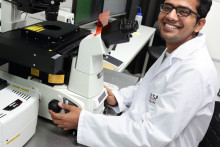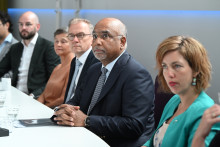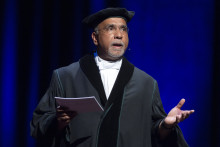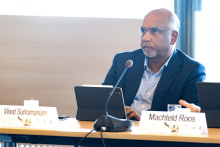Aditya is gifted. Obviously, this shows in the research that he is doing to get closer to an answer how Parkinson’s disease begins. But it also shows in the way how he communicates about it. ‘Research is worthless if you are not able to explain what you do to primary school children’, the PhD candidate believes.
Aditya guides me around the laboratory. ‘In any normal situation, muscle movement occurs when cells speak with the brain. For this neurotransmission to take place, specific molecules are needed. But people with PD do not create these molecules due to death of brain cells. This severely distorts communication with the brain.’
Molecules pour out and die
The thing is: science cannot yet answer why the brain cells die, let alone find a cure. One of the attributed reasons is hole formation in cells, for which protein clumps are somehow responsible. Aditya: ‘The initial clumps of protein-oligomers probably create holes in the membranes that usually protect the cells, causing its content to pour out and the cell to die. PD patients have an exceptionally large amount of protein clumps. I am determined to find out what happens in the very initial stages. Why do they clump?’
Vinod, Vinod, or Vinod?
Aditya was already fascinated by proteins since his Master in India. ‘I applied for a PhD position at 10 American universities, to no avail.’ A professor suggested to look at Dutch universities. Aditya found four projects of interest, and got pre-selected in all of them. ‘After being interviewed for three projects, the fourth interview was taken by Vinod Subramaniam. It was an hilarious moment to find out that actually all four projects were led by him.’
Aditya mainly uses two machines. One of them is the spectrophotometer for quantitative experiments and the other is a super-resolution microscope for qualitative measurements.. ‘When proteins aggregate, they absorb differently. I can see if they begin to clump through the intensity of the light that is emitted through the protein-sample’.
As complex as it is, things are complicated more by the fact that the PhD candidate does not use proteins directly from human cells. ‘We use proteins expressed in bacteria, because it is too difficult to extract them from human cells. However, these cells differ from each other, making it sometimes challenging to draw conclusions.’ Nevertheless, Aditya is optimistic. ‘Even if it is a drop in the ocean, knowing how and why the clumping begins can get all noses pointed in the right direction.’ Aditya believes it will take ten to fifteen years before PD can be cured.
Aadhaar
In an attempt to change the world in other ways, Aditya is part of Aadhaar. This is a charity for rural development in India, established by Indians who work at the University of Twente. ‘In India, there are many areas without electricity or access to water’, Aditya explains. One of the first projects was to establish a water pump, but the years have matured Aadhaar into an organization that invests in self-sustaining projects. ‘Recently, we installed a copy machine in a school. Its revenues ensure access to newspapers and books for local children.’
Aadhaar meets once per month and every time someone goes to India, they look for possible new projects. Aditya: ‘I am leaving for India by the end of the week. I will definitely keep my eyes open for new opportunities.’







